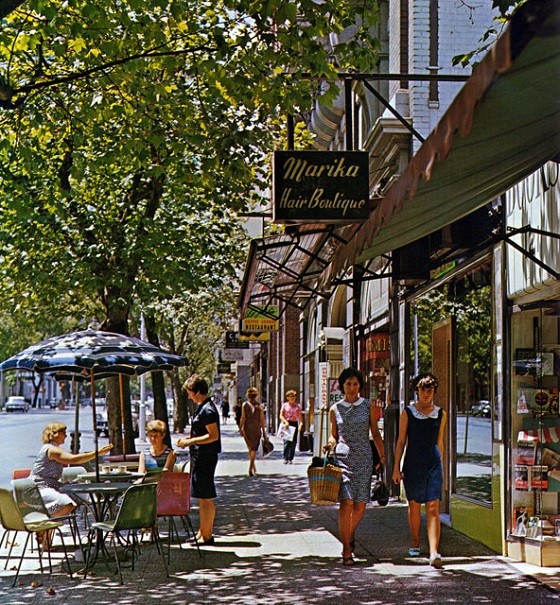
Here’s an interesting “thought experiment”: suppose those historic CBD buildings demolished in the 1960s and 70s had instead been preserved and sensitively adapted to other uses. How would our cities be different today?
To keep it simple, assume all the buildings on the main thoroughfares in the CBD remain as they were in 1940 (there wasn’t much change until the mid-1950s anyway because of WW2).
Further, assume that’s the only difference; everything else, like the string of conservative governments that dominated politics across Australia in the 1960s and most of the 70s, remains the same. (1)
I’m going to talk about Melbourne because I know it best but the lessons apply to all Australian cities. Brisbanites can imagine the Bellevue Hotel (demolished in 1979) is still there in George St and Sydneysiders can think about whether they’d prefer Bennelong Point with Fort Macquarie Tram Depot (demolished 1958) or with an Opera House.
In one respect, Melbourne’s real history is a little like my hypothetical scenario; despite the mood of “progress”, Melbourne managed to keep its trams when all around were losing theirs. (2)
The thing I’m interested in is what we might have gained, or lost, if we’d been able to freeze-frame development in these specific locations. There are doubtless multiple scenarios so I’m going to propose just one possibility.
The benefits seem reasonably straightforward. If Melbourne’s CBD had largely avoided the dead hand of post-war architectural internationalism, it would now be a more interesting and distinctive place in terms of contemporary tastes.
There would be many historically valuable buildings with profitable hospitality, retail and office uses. (3) For example, the glorious Federal Coffee Palace would’ve escaped demolition in 1973, as would the Melbourne Fish Markets (1956), The Menzies Hotel (1969), the Wool Broking Premises (1969), the Australia Building (1980), and many more.
Conversely, a modernist monstrosity like the Gas and Fuel Corporation Towers (1967) wouldn’t have been erected on a premium location like the corner of Flinders and Swanston; to do so would’ve required demolition of the remains of the historic Princes Bridge railway station.
Melbourne’s fabled Parisian ambience would’ve been preserved and would be a valuable vehicle for city branding and tourism promotion. In more recent years it might’ve been a way of helping to attract knowledge industries.
There’d be practical benefits too. The absence of office towers would mean fewer shadows and more sunlight reaches the main streets and footpaths.
There’d be other changes though with less certain benefits. There would’ve been a period of 30 years or so when Melbourne probably would’ve been regarded as backward because it rejected “progress”. It’s conceivable this could’ve hampered its ability to attract investment.
There’d be few if any high rise towers on the main streets. Corporates wouldn’t generally find historic buildings attractive because they’d be too small and inflexible. They’d mostly be occupied today by the sort of premium hospitality and retail uses that benefit most from their ambience and location.
Businesses would’ve had to look elsewhere for accommodation. Some might’ve chosen to operate out of suburban centres. Consequently, more of their employees would drive to work today.
Many more would’ve located in large near-CBD centres similar in character to North Sydney. There would’ve been greater pressure to redevelop old commercial, industrial and residential buildings in places like Fitzroy and Carlton. Warehousing and manufacturing would’ve consequently departed the inner city sooner than it did. It’s possible areas like Docklands might’ve come under earlier pressure to convert to high-rise office uses.
But many businesses, perhaps most, would’ve found accommodation in new high-rise blocks behind the main thoroughfares (where the assumed protection didn’t apply). These would’ve replaced some of the laneways, including the older buildings associated with them, that’re so celebrated today.
All those irregular, low rent commercial spaces that underpin today’s vibrant Melbourne either wouldn’t exist or, more likely, they’d be too expensive for current uses.
Given the magnificent buildings in the centre, it might’ve seemed less important to protect inner city terrace houses and warehouses. After all, the spirit of the times was for progress, not preservation.
Modernist buildings would still have been built away from the main streets. However some of the 1960s and 70s buildings that exercise the attention of preservationists today might not have been built at all.
There are other possibilities that’re even more speculative. For example, would the development capacity of the CBD have been restricted to such an extent that the city rail loop never got built? Would the decentralisation of firms have led to significantly lower public transport patronage (use of trains by commuters drops appreciably even within a few hundred metres of the loop)?
Would street life in major thoroughfares like Collins, Bourke and Swanston streets be more vibrant than it is today? Or would the loss of workers and constraints on reconfiguring heritage buildings to activate the street mean it was less alive? Would the CBD be a bit like Disneyland?
And with a strong legacy of pre-war buildings, perhaps no one would care much about protecting buildings dating from the 60s or 70s. Or perhaps it would work the other way; a city proud of its outstanding stock of heritage buildings might be more attuned to the historic value of all buildings.
My scenario is only one possibility; no doubt there’re other views of how, given the starting premise, the succeeding years might have played out. It’s also possible the same initial assumption might’ve lead to quite different results in Adelaide, Brisbane and Sydney.
I’m certainly not arguing in favour of the heritage losses suffered in the post-war period. Apart from being an interesting speculation, the value of this sort of exercise is understanding that you can’t change one parameter without realising it’ll generate knock-on changes elsewhere, not all of them what you want.
_____________________________
- Of course this is an unrealistic premise. If buildings really had been preserved it’s almost certain it would’ve been because of some far-reaching difference in values compared to what actually happened; those values would inevitably have changed many other things too. But I think that sort of “thought experiment” is less informative for current practice.
- Keeping the trams was an amazing achievement given the mood of the times (surely there’s a definitive history of why and how it happened?), but I think preserving old buildings and streetscapes would’ve been an order of magnitude harder, if only because of the huge number of private owners involved.
- Although having historical importance doesn’t mean they’d necessarily be architecturally distinguished.

'Paris end' of Collins St, 1969 (source: image via Walking Melbourne)








Crikey is committed to hosting lively discussions. Help us keep the conversation useful, interesting and welcoming. We aim to publish comments quickly in the interest of promoting robust conversation, but we’re a small team and we deploy filters to protect against legal risk. Occasionally your comment may be held up while we review, but we’re working as fast as we can to keep the conversation rolling.
The Crikey comment section is members-only content. Please subscribe to leave a comment.
The Crikey comment section is members-only content. Please login to leave a comment.